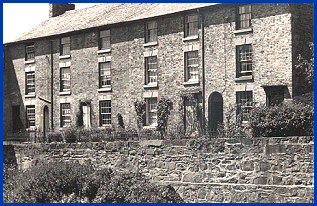
Llanidloes - the flannel makers
3
Living below the workshop
In the early part of the 19th century the processes were carried out separately, with carding, spinning and fulling operations based in water-powered factories and mills, often in remote locations, on the banks of rivers and streams. Weaving, however, was still a manual process carried out in the home or in the upper floors of specially built weavers workshops like the Llanidloes example pictured below.
Weavers houses,
Llanidloes
built 1830's
Photograph by
kind permission of
Powysland Museum

The early stages of industrialisation saw the arrival of handloom
weaving shops housed in tall three or four storey buildings,
with large open workshops on the upper floors and living quarters
for the workers beneath. There was typically an outside staircase
for direct access to the looms.
A common feature of weavers houses are the large windows in the
upper floors to admit as much light as possible. Those shown
in the old photograph above were in Highgate, near the Short
Bridge, and were built in the 1830's.
Many buildings in Llanidloes and in Newtown survive from this
domestic phase of the evolution of the flannel industry.
There are 11 pages on the flannel industry. Use the box links below to view the other pages.